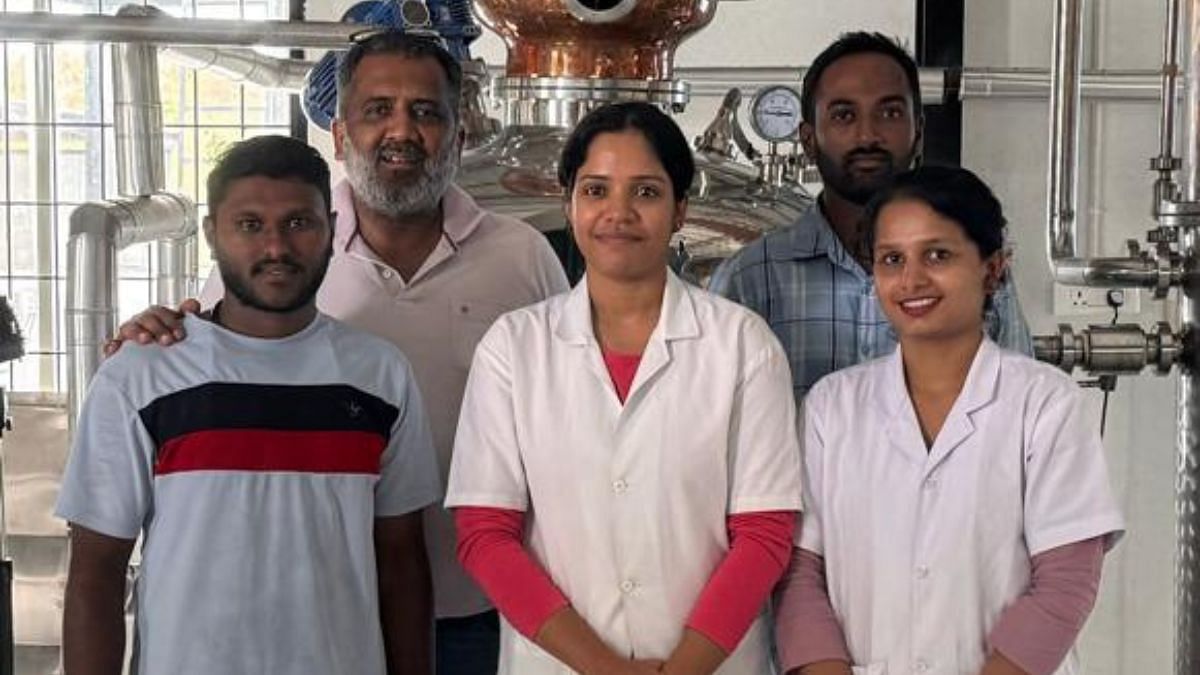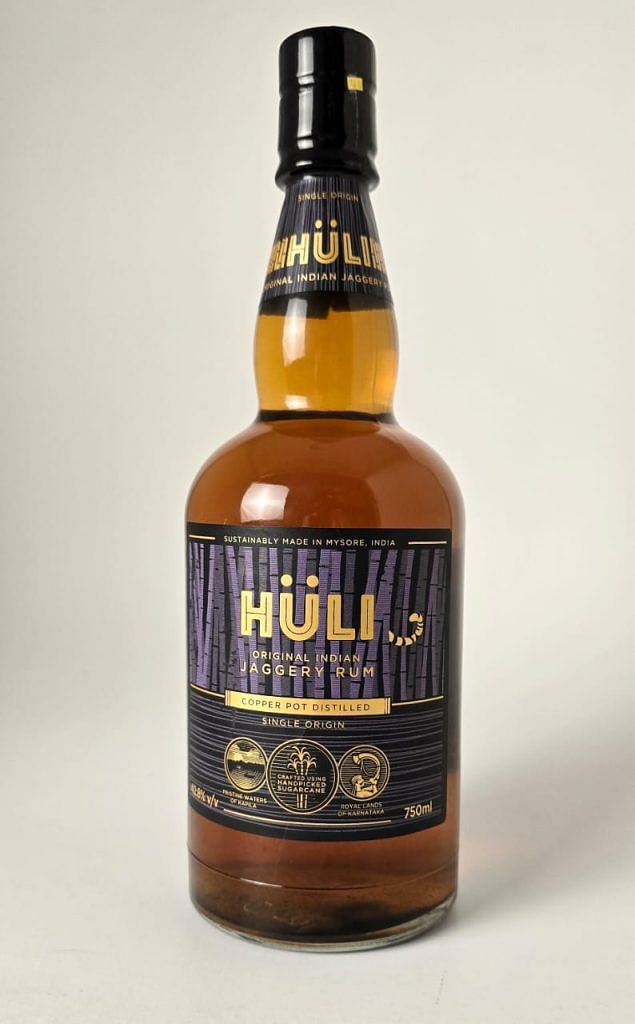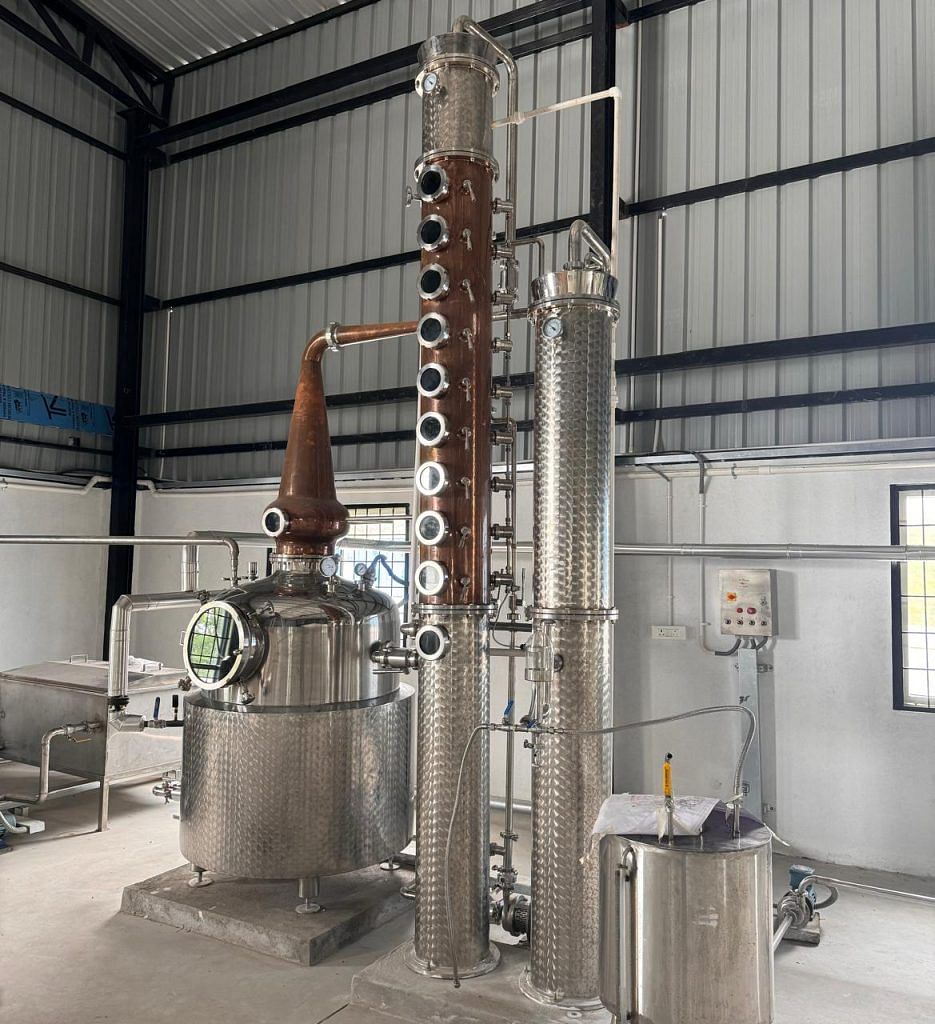New Delhi: Under the blazing sun, amid swaying sugarcane fields, Aruna Urs and Chandra S purchased a bottle of local rum from a moonshiner in Huliyar, Belgaum district. As they took their first sips, they exchanged smiles. They had finally stumbled upon something special.
“We had found a liquor with real market potential,” Urs told The Print, just days before launching India’s first jaggery-based rum, Huli.
After eight years of hard work, the first batch of Huli, around 2,000 bottles, is set to hit the markets of Bengaluru and Mysuru on 15 August.
“Rum, in India, has an image of being a poor man’s drink,” Urs said. But, Huli is premium. Its target audience is 35-55-year-olds, both male and female because rum is no longer just for men.
India is one of the fastest-growing alcoholic beverages markets. In 2023, the market size was about $55 billion. It is likely to increase at a CAGR of seven per cent to $73 billion in 2027.
Huli, Kannada for Tiger, is a single-origin jaggery rum handcrafted at the country’s first micro-distillery. The 750ml bottle is priced at Rs 630. When excise duty and retailer’s margin are added, the bottle is available for the public at the price of Rs 2,800.
Rum, in India, has an image of being a poor man’s drink
– Aruna Urs, co-founder, Huli
Huli happened purely by luck. Urs and Chandra’s original plan was far from this.
The duo set out in 2014 to bottle up arrack, made from the fermented sap of coconut flowers or sugarcane. But, it has been prohibited in the state since 2007.
“We were back to square one. Around the same time, the state government made an amendment allowing distillers to use jaggery,” said Urs.

Urs and Chandra sampled over 20 sugarcane liquors in Karnataka villages, in 2015, some passable and others downright terrible, before finding gold in Huliyar.
In 2016, they rented half an acre of land to set up the micro-distillery. Eight years later, they’re ready for the market.
Also read: UP is the new liquor capital—Record revenues, home bars, model shops. Yogi govt loving it
Jaggery is gold
Jaggery distillation isn’t new. It has a history of over 1,000 years in India. Jaggery was the most available form of sugar that lends itself to fermentation.
Even today, in sugarcane-growing areas, locals make their alcohol at home. They spice the beverage with cinnamon, star anise or other local spices and store it in earthen pots. Though it is an illegal practice, it persists. But was restricted to small villages and towns.
Now it’s entering the urban market with a roar. And it’s not just Huli, even Amrut, the pioneer of Indian single-malt whisky, is expanding its portfolio. The brand has registered a name—Bella—for a jaggery rum, revealed Urs on X.
Foreign brands, predominantly, use brown sugar but it cannot beat the flavour jaggery offers. It’s a traditional product. It has an Indianness to it
– Aruna Urs, co-founder, Huli
Rum has three categories: white, dark and golden. Huli falls in the third category. A minuscule drop of caramel gives it a distinct hue and allows manufacturers to keep the colour standard across batches.
“Foreign brands, predominantly, use brown sugar but it cannot beat the flavour jaggery offers,” said Urs.
Jaggery is rich in minerals and micro-nutrients.

“And, it is readily available in India. It’s a traditional product. It has an Indianness to it,” he added.
Huli is the “refined” version of the local liquor that Urs and Chandra tasted in Huliyar. They’ve automated most of the process. According to Urs, hygiene alone brings a significant change in taste.
But, running a distillery is no easy job. It weighs heavily on the pocket.
The annual license fee is Rs 52 lakh in Karnataka. Urs pays an additional Rs 10.3 lakh for distilling jaggery and Rs 1 lakh for bottling charges.
“It’s tough but the passion to bring back these lost gems makes it all worth it,” Urs said.
Also read: Royal, rich, Rajputi—Indian single malt whisky now global cool. A new culture being distilled
The rum market
India has always been a rum-drinking country. But, there’s been a dearth of good-quality rums.
“It is a Caribbean drink,” said Rohan Carvalho, founder, Bar Square Academy of Bartending. People working on sugar plantations discovered that molasses could be used for making alcohol.
“Later, colonisation and trade made the spirit popular around the world,” he said.

In India, everyone is familiar with Old Monk, even the non-drinkers. But, Indian rums have evolved. Lately, a host of homegrown brands—like Short Story, Maka Zai and Camikara—have been sprucing up the country’s rum scene.
“Who says we don’t have good rums? Can you guess which rum was given top-shelf in 2011 globally? It was McDowell’s No. 1 from India,” Carvalho said.
The industry expert has tried quite a variety of rums, and is looking forward to tasting Huli. “It will be interesting to see the notes of jaggery in the spirit and how it has been balanced,” he said.
Also read: Tulsi to strawberry—How desi gin from Goa is converting India’s vodka loyalists
Sugarcane fields to marketplaces
A bottle of Huli takes four and a half years to get ready. The journey begins in the sugarcane field, where farmers plant a specific variety of the plant in a circular method.
The first harvest is done after 14 months. It is sent to a jaggery maker. They heat the sugarcane juice and deliver the final product, powdered jaggery to Urs’ factory.
The heart of the factory is its laboratory. And, the heavyweight here is yeast.
“The first step is to do media preparation for the strain of yeast using potato dextrose (a basic food for the yeast). Once the yeast is cultivated in the media, we transfer it to the fermentation tanks,” said Arpitha Nayak, a biochemist working at the factory.
The fermentation lasts for 36-48 hours depending on the temperature and humidity. The next step is a five to six-hour distillation, which is handled by Urs and his colleague Punith Kumar.
“We also keep the alcohol in receiver tanks for 36 hours. It is a mandatory term from the excise department,” said Kumar, who has been working with Urs since 2016.
Recalling the hurdles, failures, and numerous tests, Kumar expressed that he is proud of every day that went behind shaping the product.
“I am exhausted, in a good way, but equally excited to see the response,” he said.
Once the 36-hour period is over, it’s moved to ageing tanks for six to twelve months. At this point, the alcohol content is very high, close to 88 per cent.
Therefore, proofing is essential, which brings down the alcohol content to the bottling strength of 42.8 per cent. It is done using demineralised water.
And, finally, Huli is ready.
Urs’ micro-distillery produces 60,000 bottles of jaggery rum, 750ml each, annually.
He’s been very transparent on X about the process of making rum and opening a distillery, giving his followers a price breakdown and even resources to turn to. But there’s one secret he holds close—the variety of sugarcane he uses.
“Can’t tell the name. It’s a trade secret, boss,” he said, laughing.
(Edited by Theres Sudeep)






